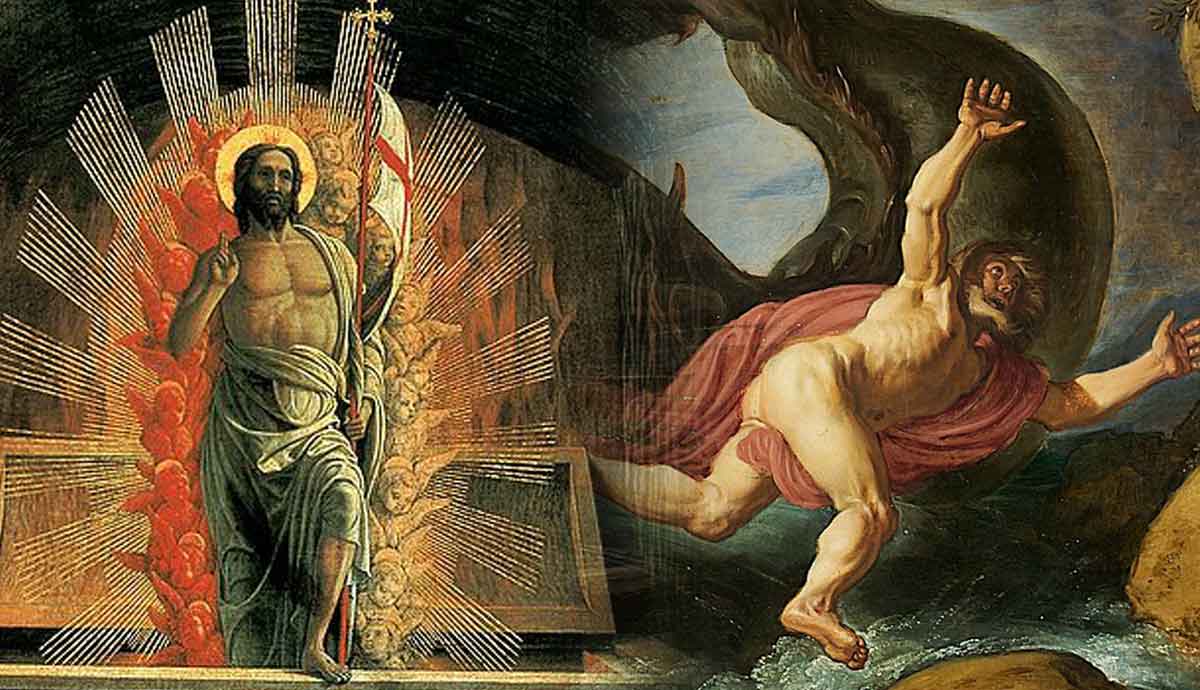
The Gospel of Matthew refers to the sign of Jonah on two occasions and the Gospel of Luke, once (Matthew 12:39-41; Matthew 16:4; Luke 11:29-30). Matthew 12:39-41 specifies a detail that the other two do not. In the minds of many, this detail results in a contradiction in the Bible. It draws an equivalence between the time Jonah spent in the belly of the great fish and the time Jesus spent in the heart of the earth. Does this mean Jesus would be in the grave for three days and three nights?
What Happened to Jonah and the Great Fish?

In Matthew 12, the sign of Jonah serves as an example of what Jesus would endure. Matthew 12:39-40 says:
“An evil and adulterous generation seeks for a sign, but no sign will be given to it except the sign of the prophet Jonah. For just as Jonah was three days and three nights in the belly of the great fish, so will the Son of Man be three days and three nights in the heart of the earth.”
According to Jonah 1:17, Jonah was swallowed by a great fish and spent three days and three nights in its belly. The text does not explicitly state that Jonah died, but neither does it say he did not die. The text does say that Jonah was not dead initially, because Jonah prayed in great distress from the belly of the fish. The language suggests that Jonah died because the “waters closed in over me to take my life” and God “brought up my life from the pit” (Jonah 2:5-7 ESV). The duration of time Jonah was in the belly of the fish was three nights and three days, then the fish vomited Jonah out on dry land.
If the heart of the earth was a metaphor for the grave, does this not mean Jesus was in the grave for 72 hours?
Inclusive Reckoning

It is imperative to understand the difference between how we calculate time today and how it was done in Biblical times in the Jewish community. We think of a day as a cycle of 24 hours. To us, three days would be a period of 72 hours but is that how time was calculated in the Bible? Let’s see what we can glean from Scripture.
In Luke 13:32-33, Jesus says: “Go and tell that fox, ‘Behold, I cast out demons and perform cures today and tomorrow, and the third day I finish my course. Nevertheless, I must go on my way today and tomorrow and the day following, for it cannot be that a prophet should perish away from Jerusalem.’” To Jesus, the day after tomorrow was the third day, but it would be in two days’ time by our reckoning.
We see something similar in Luke 24. It was a Sunday, the first day of the week, when Jesus spoke to two men on their way to Emmaus (Luke 24:1 and 13). They were unaware of who they were conversing with and told Jesus: “But we had hoped that he was the one to redeem Israel. Yes, and besides all this, it is now the third day since these things happened.” The Sunday being the third day, would make Saturday (Sabbath) the second day, and Friday the first day. This correlates with John 19:31 which states that it was the preparation day, Friday, that Jesus was on the cross and the Jews wanted the legs of the men on the crosses broken because the Sabbath (Friday evening and Saturday) was drawing near.

To Jewish minds, any part of a day counted as a full day. That is the only way the day after tomorrow could be the third day, and counting from the day before yesterday could make today the third day. Scholars refer to this phenomenon as “inclusive reckoning.” It applied to the reckoning of years as well. In Genesis 7:11, it states that the flood occurred in “the six hundredth year of Noah’s life,” but five verses earlier, in Genesis 7:6, it says: “Noah was six hundred years old when the flood of waters came upon the earth.” The only way to harmonize these numbers is by accepting the principle of inclusive reckoning.
Jesus was crucified around 3:00pm on Friday, which would account for the daylight hours of Friday being included. His rising on Sunday at daybreak would account for the daylight hours on Sunday based on inclusive reckoning. Based on inclusive reckoning, this would be a period of three days.
Three Days and Three Nights

The problem with only relying on inclusive reckoning is that the text specifies three days and three nights, not just three days. Using inclusive reckoning, the daylight hours of Friday, Saturday (Sabbath), and Sunday, and the nights of Friday/Saturday and Saturday/Sunday can be accounted for, but we would still be short one night.
Here it is important to note that to the ancient Jewish mind, a day started with sunset. A day was defined in Genesis 1 already. “And there was evening and there was morning,” with the number of the day sequence following the expression (Genesis 1:5, 8, 13, 19, 23, and 31). So, a day starts with sunset and ends with sunset. Therefore, the relevant evening would have to be the Thursday evening in our reckoning, which would be part of the Friday to a Jew. But Jesus was not placed in the grave on Thursday evening.

Some readers may see the fact that Jesus was not in the tomb for three days and three nights, while the sign of Jonah refers to being in the “heart of the earth” as a contradiction in the Bible — but is it? It would be a contradiction if “heart of the earth” meant grave, but there is no reason to equate one with the other. Remember that in Biblical times, people were not usually buried in a hole in the ground like today. Jesus was placed in an above-ground tomb. That is hardly the “heart of the earth.”
The term “heart of the earth” is a translation of kardia which literally means heart but figuratively refers to feelings, mind, or thoughts, and ghay can be translated as earth, land, or world. None of these meanings point to a grave. A much more likely interpretation of what “heart of the earth” refers to would be “mind of the world.”
Context of the Sign of Jonah

Considering the context in which we encounter the sign of Jonah, we note that the preceding verses point to mind or intent, rather than anything else.
Matthew 12:35-37
“You brood of vipers! How can you speak good, when you are evil? For out of the abundance of the heart the mouth speaks. The good person out of his good treasure brings forth good, and the evil person out of his evil treasure brings forth evil. I tell you, on the day of judgment people will give account for every careless word they speak, for by your words you will be justified, and by your words you will be condemned.”
In this context, the Pharisees asked for a sign, and Jesus referred to the sign of Jonah. Heart of the earth, therefore, refers to the will and intent of the “evil and adulterous generation [who] seeks for a sign” (Matthew 12:39).
We can test this theory by considering what the Bible says happened. From the Thursday evening in which Jesus was betrayed, arrested, and tried, he was under the control of those who had a worldly intent to kill him.
Parallels Between Jonah and Jesus

Jonah 2 relates how Jonah was swallowed by the great fish. During that time, Jonah was at the mercy of the fish. His freedom was taken away and he was left to the will, actions, and results of whatever the fish did. Jonah did not die immediately. He prayed intensely, experiencing the agony of what was about to happen to him. He knew he was about to die.
This perfectly parallels the experience of Jesus. In Luke 22:44, the author of the Gospel of Luke describes the intense time of prayer Jesus experienced in the Garden of Gethsemane. His freedom was then taken away when he was betrayed, arrested, and tried. He was at the mercy of those with evil intent who wanted to kill him. Jesus knew he was about to die, and did. For three nights and three days, as with Jonah, the whims of the forces that took control of the life of Jesus played out until he was resurrected.
Biblical Motivation for Including Thursday Evening

When Jesus foretold what would happen to him, he said he would “suffer many things from the elders and chief priests and scribes, and be killed, and on the third day be raised” (Matthew 16:21. See also Mark 8:31). Matthew 17:22-23, 20:18-19 and Luke 18:31-33 also include his delivery, suffering, crucifixion, death, and resurrection in the three days.
Reflecting on what happened, the two men on their way to Emmaus which we referred to earlier also included the events of the Thursday in their reckoning of three days (Luke 24:19-21). Jesus similarly said: “Thus it is written, that the Christ should suffer and on the third day rise from the dead.” The suffering started on Thursday and the results of what the evil generation did to Jesus lasted until Sunday morning when he was resurrected, thus covering three nights and three days.
The sign of Jonah draws a parallel between the time of suffering and the death of Jonah and Jesus. In both cases, they were stripped of their freedom and left to the mercy of external forces who killed them for three nights and three days. In the case of Jesus, it started on Thursday with his betrayal, delivery, suffering, trials, and eventual death and ended with his resurrection on Sunday morning.










